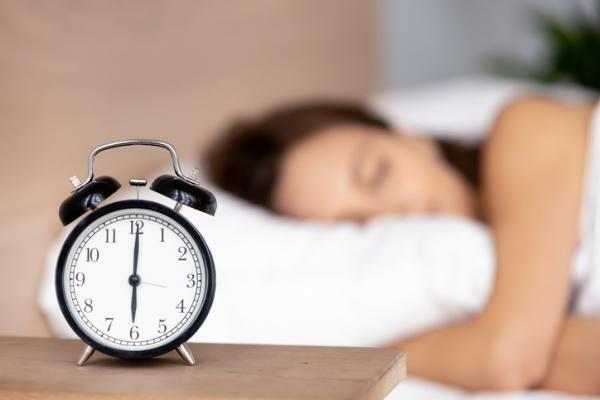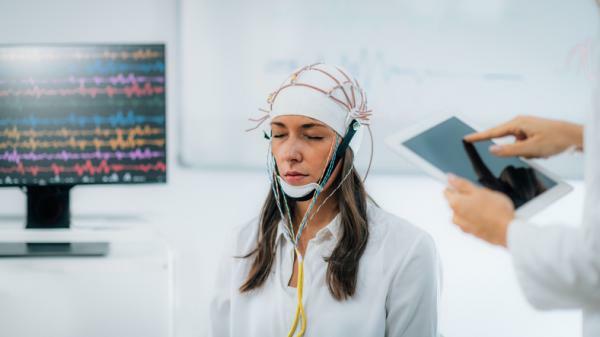
Dreams are one of the best known and most faithful manifestations of the unconscious and that makes us feel a great attraction for its world and its secrets. In waking state, we remember only small parts of the content of all that ephemeral but vast dream material. What exactly are dreams? Why do we dream what we dream? Can we dream what we want? Imagine the possibility of dreaming precisely what you want: places, people, memories, animals... In this Psychology-Online article, we explain to you how to control dreams.
Index
- Can dreams be controlled?
- What are lucid dreams
- What is a oneironaut
- How to have lucid dreams and control what you dream
- Sleep study
- Phases of sleep and brain waves
Can dreams be controlled?
The content of dreams is usually random and consists of disorganized sequences. In dreams, scenes often appear discontinuous, intermittent, interrupted and confused. In addition to these main characteristics, dreams usually manifest without any relation to experiences previous or known: scenes that have nothing to do with each other, or with dream material incompatible.
Dreams are often confused and superfluous in appearance. For this reason, we often consider ignoring and forgetting them, especially if they have caused some kind of disturbance or discomfort. But, paradoxically, in dreams appears content related to the unconscious of the dreamer. Unpleasant content can manifest itself, but also content that is gratifying and pleasant originating from the deepest desires and longings (but often socially or morally shameful).
Some people have also found a lot of pleasure in the dream world and express a great desire to stay longer in a dream. Are people have learned to control that dream world through a type of dream known as dreams lucid. Here we explain more about what lucid dreams are and how to get to have them, so you will learn to control dreams.
What are lucid dreams.
A lucid dream it is simply the be aware of what you are dreaming of. These types of dreams are often experienced in childhood and after experiencing sleep paralysis.
In lucid dreams, people can become aware that what they are experiencing is a dream manifestation and, by being aware of this, they can also achieve the manipulation of these dreams, that is, the person is able to create all the material (scenes and people) voluntarily.
For example, a person who experiences a lucid dream may stage someone with whom it is difficult to relate (some famous person, ex-partners, deceased relatives ...) and perform actions common in the waking state (conversations, sharing a coffee, walking, even having sex with they).
Some people not only use these dreams to experience pleasure, but also to stage content as a traumatic scene (accidents, violations, abandonments ...) in order to heal or restructure all this unconscious material.
There are people who have also used lucid dreaming as source of creativity. For example, the famous painter Salvador Dalí used the "spoon nap" technique, which consists of holding a spoon between the hand and a just plate. below it, when falling asleep the spoon fell and hit the plate waking up the painter, in this way, the artist painted the images that he saw before awakening.
Some people have been induced to lucid dreams by simple experience, such as flying, jumping great distances, diving, skydiving, and many other experiences.

What is a oneironaut.
A oneironaut is the name by which the person who takes on a waking state of consciousness while dreaming, they experience what we call lucid dreams.
Most people experience lucid dreaming throughout their lives. Although they often occur in childhood, there are also people who maintain this ability throughout their lives and very regularly (almost daily).
Oneironauts can reach trigger that lucid dream state voluntarily through various methods and techniques. This makes oneironauts able to enter a lucid state almost voluntarily and with great success during sleep. Next we will see how to dream what you want.
How to have lucid dreams and control what you dream.
Lucid dreams are events that many people want to experience or have ever experienced and that would like to do it again, so below we share some tips to learn to control the dreams:
1. MILD technique (Mnemonic Induced Lucid Dream)
The MILD technique is one of the most used and effective techniques for induce lucid dreams. It is effective for beginners and expert oneironauts. This technique was developed by Stephen LaBerge and described in his book "Exploring Lucid Dreaming."
In the text, Laberge explains the steps to carry out the technique. In this book, three processes important psychological factors that are the basis of the technique: motivation, intention and association.
- In the motivation It is important that you ask yourself why you want to achieve lucidity in your dreams. It is a question that must be asked continuously, since it is the one that generates the topic of interest in the dream, and thus the intention is produced to delve into a certain topic.
- A intention Sustained it promotes the will and, therefore, this activity usually becomes a habit.
- The association progressively trains as we are able to ask ourselves if we are really in a dream, associating or integrating all the previous elements (critical reflection, reality tests and dream signs personal).
2. Brief awakening
The MILD technique should be put into practice after a period of sleep in which the body has had enough rest. There are people who first sleep 6 hours before practicing, and for others 4 and a half hours is enough.
Miguel Gasca (2017) reminds us that to measure sleep, periods of 1 hour and a half approximately. This happens because, regularly, a full sleep cycle, with all its phases, lasts approximately that long. Then there is a brief awakening, of which the person is not usually aware, and then another cycle of sleep begins.
If you manage to achieve lucidity during the first few cycles of sleep, you may feel tired when you wake up. When you sleep, the first cycles are more oriented to the rest of the physical body, and therefore the slow wave phase is longer. On the other hand, in last cycles of sleep the REM phase, which is in where most dreams happen, are longer. And therefore there is a better chance that lucidity will be achieved. It is for this reason that most people have achieved this awareness about dreams after a brief awakening to go to the bathroom and go back to bed or to turn off the alarm clock, they even report having sleep paralysis which are the ones that open the doors to lucidity. Therefore, setting an alarm to have a little awakening and continue sleeping is one of the tricks to dream what you want.
3. Write down dreams
Having a clear intention of lucidity contributes to the success of the technique. Many people use dream diaries, where they write down each one of them in the first moment after waking up, in this way they practice their intention.
4. Yoga
It is another of the alternative techniques to achieve lucidity in dreams. It consists of a state of intermediate consciousness, a physical and mental relaxation.
It consists of relaxation through the concentration of consciousness. The steps are very simple to follow, but like the other techniques it requires practice to achieve the level of lucidity.
It is performed lying on the back with the eyes closed (some do it blindfolded) the arms separated from the body and the palms of the hands facing upwards. The legs should be open to the width of the hips and the balls of the feet outwards (to the sides).
Being in the correct position, the attention begins to center inwards; awareness of the rhythm of breathing and heartbeat. Later, the focus is on a specific part of the body (such as a leg, a hand or a foot). This awareness explores the body, moving muscle by muscle and consciously releasing all tension in sync with a deep breath.
Having achieved this awareness of the body and the cancellation of tension, one enters dreamlike state of serenity. In this state, you begin to focus again on your breath and on each of the dream elements that are presented.
5. Identify personal dream signs
It is important that people who wish to begin the experience of lucid dreams, that is, the control dreams, form signals during your waking state that function as triggers during dreams Personal dream signs are topics that are generally carried with them for a lifetime: fears, wishes or wishes. For example, some people have as dream signs stamped vehicles, animals, known people (former partners), embarrassing events... These signs are frequently material that occurs in most dreams, which is why it is recommended that when waking up from any type of dream (even if it is not lucid) note the objects, places, people and subjects that appear more than once. Identifying these dream signals will habituate the subconscious to distinguish them the next time they appear.
For example, if dream about the old couple it can be used as a trigger to realize that you are dreaming. Next, a reality check should be performed.
6. Take a reality check
Reality tests are performed as check method by recognizing any of the triggers (for example, the ex-partner or a room). A reality check would be, for example, trying to pierce the palm of the hand with a finger, look at your hand and observe signs.
In the waking state, what is being seen is very evident, not in dreams. For example, detect anomalies when looking at the hands (instead of five fingers there are six), look at the sky (many times there are more than one moon), see signs or hand clocks (look at it and look away for a few seconds to see it again, in the second observation of the object the letters have changed).
It is advisable to have two or three reality tests because dreams often deceive us. For example, many times the finger does not cross and thus we can verify with a second test how to jump from the road to the top floor of a fifty-story building. Some people use extreme reality tests because it works for them or because they are the ones they learned to test with. For example, hurting your skin.
These reality tests are actions that are performed in the waking state as well as in the dream. to know if we are awake or asleep. When there is something unexpected, you have to do a reality test because in dreams there are many unexpected things.
7. Reflect and ask
We all have that feeling of knowing that we are awake but that it can be transferred to sleep (we feel that we are awake in sleep and what it causes are false awakenings). The antidote to this deception is to ask ourselves throughout the day: "Now am I awake or asleep?", and then perform a reality test such as looking around to see if everything is stable. The difference from the waking state is precisely the stability, since in the dream most things are unstable.
A well-known reference in reality testing is the one used in the movie Inception, directed by Chritopher Nolan in where they have Totems (fetish objects that serve as reality tests) such as using a coin that has words written.

The study of sleep.
Lucid dreaming is like a hybrid state between sleep and wakefulness. In ordinary sleep the prefrontal cortex of the brain is inactive, in the lucid dream this more active and it is for this reason that we are able to control or be aware of dreams.
The study of human sleep is done in a sleep laboratory. These are usually located in medical centers and consist of one or more bedrooms adjoining an observation room, which is where the experimenter spends the night. The experimenter prepares the subject to be observed by placing electrodes on the scalp, chin, and outer edge of the eyes.
- Electrodes placed on the scalp allow the recording of the electrical activity of the brain using an EEG.
- On the other hand, the electrodes placed on the chin allow to detect the muscle activity using an electromyogram.
- While the electrodes located at the extreme edge of the eyes record the eye movements using an electrooculogram.
- In addition to these, other electrodes and devices can be used to record neurovegetative measurements such as heart rate and respiration.
During a normal night, most of us experience five phases of sleep, which are phase 1, 2, 3, 4 and REM sleep phase (short for Rapid Eye Movement) also known by its acronym in Spanish "the MOR dream" (Dreams of Rapid Eye Movements).
Sleep researchers have described four types of brain waves involved in the different phases of sleep:
- Beta waves
- Alpha waves
- Theta waves
- Delta waves
Specific patterns of muscle activity, blood pressure, and body temperature are observed in each phase of sleep. Just as our waking state is marked by characteristic patterns of these brain waves.
The waking state It is characterized by two different types of brain waves which are Beta waves and Alpha waves.
- The Beta waves are low-altitude, high-frequency waves seen when a person is fully awake and alert. In addition, they have irregular electrical activity and occur between 13 and 30 cycles per second.
- On the other hand we have the Alpha waves, which are larger waves and are more synchronized than Beta waves. They are observed when a person is relaxed, with the eyes closed and also present a moderate frequency electrical activity and occur between 8 and 12 cycles per second.

Phases of sleep and brain waves.
In what phase of sleep do we dream? Each of the phases of sleep is explained in depth below and in which of them dreams are experienced.
Sleep phase 1
Phase one of sleep is a transitional phase from wakefulness to sleep that usually lasts a few minutes. During this phase, most of us are easily awakened by noise or some other disturbances.
During phase 1 a pattern of Theta waves, which are synchronized waves larger than Beta and Alpha waves, and occur at 4 to 7 cycles per second. Thus when a person begins to fall asleep, the heart rate slows down, the eyes can swing from one side to the other and the muscles relax, it can even occur small muscle jerks that sometimes wake up the person.
Sleep phase 2
In this phase, two different EEG patterns are observed; here we can locate the different spindles or sigmas of sleep (which we can also find with their name in English: spindles) and, on the other hand, we have the K complexes.
- The sleep spindles they are brief bursts or sets of waves of 12 to 14 cycles per second, which occur between 2 and 5 times per minute during sleep phases 1, 2, 3 and 4.
- On the other hand we have the K complexes, which are sharp and sudden waves that, unlike sleep spindles, can only or are usually only observed in phase 2 of sleep. K complexes occur spontaneously, with a frequency of approximately 1 per minute, but can often be caused by noise (especially unexpected noise). It has even been shown that the K complexes triggered by some auditory stimulus represent an inhibition mechanism that appears to protect the sleeper from awakening. Thus, as we fall asleep, brain activity slows down, then increases, then slows down again, and so on.
Thus we understand that sleep spindles and K complexes reflect the transition from being awake to being asleep.
Sleep phase 3
Sleep phases 3 and 4 are known as dreams of slow waves. In phase 3, breathing and heart rate decrease, the muscles also relax, and it is difficult to wake the person who is sleeping.
The deep relaxation phase 3 can cause problems such as nocturnal enuresis. In addition, it must be taken into account that as sleep becomes deeper, brain activity changes from a high frequency, small amplitude wave to a low frequency wave and a large amplitude.
Thus, these slow waves with high peaks seen in phase 3 are called delta waves, these waves present a synchronized electrical activity of less than 4 cycles per second.
Sleep phase 4
In phase 4, delta waves low frequency and high amplitude take over and the person is in a deep sleep. The following physiological parameters are at their lowest point: heart rate, respiratory rate, blood pressure, and body temperature. For this reason, some researchers have associated phase 4 with coma or unconsciousness, but curiously in the phases Sleep 3 and 4 are the phases in which people are most likely to walk, since in this phase there is muscle tone moderate.
REM phase
It is named for the rapid eye movements that sleepers perform during this phase. REM sleep is the setting in which dreams occur story type that include most nightmares. During the REM phase, the brain begins to skip bursts of very fast waves (heart rate, blood pressure, and breathing increase and become irregular).
During this phase, the absence of muscle tone is also observed, which implies physical movement.
The interesting thing about the REM phase is that brain activity of a person in REM sleep resembles that of a person who is fully awake, even though the person is in deep sleep. Thus, the recording of an electroencephalogram in REM sleep resembles that of an awake person, that is, both states show Beta activity u Beta waves.
During a sleep cycle normal, a person goes from being awake to the phases of sleep, that is, the subject goes from light sleep (phase 1) to sleep phase 3 and 4 and then back down through the stages (it goes from phase 4 to phase 3, then to phase 2 and returns to the phase 1). People enter REM sleep on their first return to phase 1 sleep. Most people go from 4 to 5 cycles and each cycle takes about one hour and half, we wake up and go back to sleep. But of those awakenings we are not aware.
When we fall asleep, an area of the brainstem is deactivated so as not to make the movements that we make when we are dreaming.
This article is merely informative, in Psychology-Online we do not have the power to make a diagnosis or recommend a treatment. We invite you to go to a psychologist to treat your particular case.
If you want to read more articles similar to How to control dreams, we recommend that you enter our category of Dreams meaning.
Bibliography
- Allan B. Wallace. (2018). Dreaming that you are awake. Dharma. Alicante.
- Carlson, N. (2006). Sleep and biological rhythms. Carlson, N. Behavioral physiology, 302-337.


